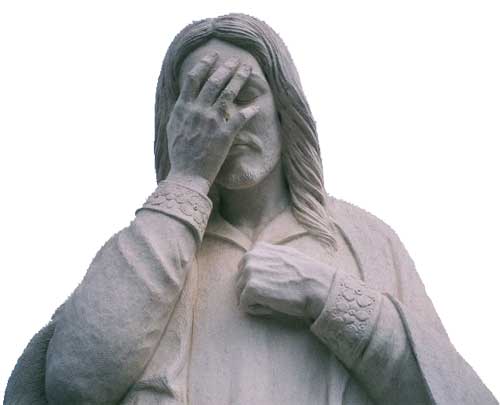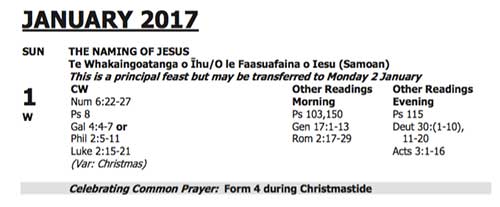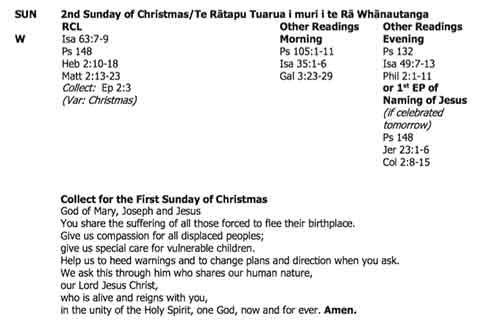
So, formally, it is called “The Anglican Church in Aotearoa, New Zealand and Polynesia”. That’s a mouthful even some of the leadership cannot get correct. Because of its many options (including, if you like, variants to its formal name), here it’s often known as “The Anglican Church of Or“.
If you don’t want to read this whole post, here is the take-home message: liturgy generally, and the lectionary specifically, is presented as an opaque, esoteric hobby that even the top experts of our church cannot agree on or get right. Why bother with it?! Any of it.
Usually, at this time of the week, I provide resources for the next week.
Let’s start by looking at what the Lectionary booklet of the Anglican Church of Or suggests.

The Lectionary booklet, you notice, has, THE NAMING OF JESUS “is a principal feast but may be transferred to Monday 2 January”. Well, that is false.
The formulary of our Church, binding on us in teaching and practice, Notes on the Calendar and Precedence inLiturgical Observance is perfectly clear:
The Naming of Jesus is a Principal Feast and the liturgical provision for it, should not be displaced by any other celebration!
But wait, there’s more: In the Lectionary booklet, this Principal feast of our province, The Naming of Jesus, is provided with readings from “CW” – the Church of England’s Common Worship, a resource that has no status in this province. So, on a principal feast of our province, our church appears to have no readings of our own provided. That, of course, is false. We have readings provided for this feast in fact as a formulary of our church on page 643 of our New Zealand Prayer Book He Karakia Mihinare o Aotearoa (ANZPB/HKMOA). So when our Lectionary booklet says (on page 2) that CW is in this booklet “when provision is not made in RCL or in ANZPB/HKMOA” – that too is false, for this is a day when such provision is certainly made in ANZPB/HKMOA.
Let’s just underline, before we proceed, that formularies have gone through the following process: Passed by General Synod Te Hinota Whanui (GSTHW); Passed by a majority of diocesan synods and Hui Amorangi; Passed by at least a 2/3 majority in each House (and by all three Tikanga) of a new meeting of GSTHW; introduced a year later to give a year for anyone to protest (and to get used to the change).
The Lectionary booklet also appears to me to appropriate authority to itself that it just does not have. On page 138 it gives its own version of “PRECEDENCE IN LITURGICAL OBSERVANCE” stating that, “General Synod made the following provisions for precedence in liturgical observance.” Under this, it claims that “[Principal Feasts] are not normally displaced by any other celebration except in accord with the guidelines provided by General Synod as indicated in The Lectionary.” In other words, this Lectionary gives the impression (and makes the claim) that its option of displacing The Naming of Jesus is authorised by General Synod. If that is the case – someone could please point to where GSTHW indicates that. For my money, the formularies we vow to and sign up to trump (apologies for the use of that word!) the annual Lectionary booklet. And, until I am shown otherwise, the Lectionary booklet’s claim that displacement “indicated in The Lectionary” is part of the actual “PRECEDENCE IN LITURGICAL OBSERVANCE” agreed to by GSTHW, I hold that statement too to be false.
Let’s now proceed to the next issue as we begin 2017:

Remember how I said our church would get confused about the new naming system General Synod wants us to use for Sundays? Well, I’ve already had a number of people get in touch with me that calling January 1 2017 “2nd Sunday of Christmas” is a mistake. But maybe it isn’t. Christmas Day was a Sunday – so that could be counted as the first Sunday of Christmas.
But even the Lectionary booklet doesn’t have the courage of its convictions, and follows the title “2nd Sunday of Christmas” with the “Collect for the First Sunday of Christmas”!
In any case, if – as, remember, is required – we follow the formularies, whenever Christmas falls on a Sunday, the next Sunday is celebrated as The Naming of Jesus.
[You get extra points for noticing that the readings provided for this year’s “2nd Sunday of Christmas” are, in fact, the readings for the First Sunday of Christmas.]
But wait there’s more options for this coming Sunday in the Anglican Church of Or:

So two full pages of our Lectionary booklet provide options for Sunday 1 January (when, remember, only The Naming of Jesus is what is required – or allowed – by the formularies we promise and sign up to follow). Then the Lectionary has five pages of variants depending on when you celebrate Epiphany (on page 23 they seem to have accidentally omitted the heading that this is a variant page, a heading provided on all the other pages. This lack of a heading there means that four pages over, where once again we have no heading, it is unclear that page 27 is where we are all back together again).
The Anglican Church of Or begins counting Sundays in Ordinary Time on February 5. That first Sunday in Ordinary Time, to keep with the sense of esoteric confusion, it calls the “5th Sunday in Ordinary Time”.
With all these variants, confusions, and uncertainties, it is little wonder that I’ve had reported that the readings for a close-to-but-not-quite-midnight service on Christmas Eve were thought to be those provided for in “The Eve and Vigil of Christmas” on December 24, when, in fact, Christmas Eve services are provided for on December 25 (and called, once again esoterically, “Proper I, Proper II, Proper III”).
Yes, liturgy generally, and the lectionary specifically, is presented as an opaque, esoteric hobby that even the top experts of our church cannot agree on or get right. Why bother with it?! Any of it. The calls by me (echoed and reinforced by motions passed in our diocesan synod) to review and renew our liturgical rules so that they are simple, and clearly indicate what is required, allowed, and forbidden have been ignored. Instead more complexity has been patched onto greater confusion, so that those of us who commit to it (with the small numbers that we are) cannot practice the joy of common prayer, which includes reading the same readings. Common Prayer was once a defining foundation of Anglicanism.
*****
Whether you regard the Christmas Season as concluding on Christmas Day, Epiphany, the Baptism of the Lord, Candlemas, the Sunday following Candlemas, or are Orthodox, or Armenian, and celebrate the Incarnation on another day and see the season differently… in the Southern Hemisphere, and certainly in Aotearoa-New Zealand, this is our go-slow time…
If you appreciated this post, do remember to like the liturgy facebook page, use the RSS feed, and signing up for a not-very-often email, …



While appreciating and supporting, Bosco, the call for simplification and clarification of our rules, I note that an important part of your analysis is the conclusion that we have some clear rules and are not following them!
Thanks, Peter. A very good point, well highlighted. Christmas Season blessings.
Looks like your NZ lectionary needs an editor-in-chief with an obsessive eye for detail and consistency– perhaps your good self should volunteer! We don’t seem to have problems with ours in Oz other than objections from Sydney about scripture passages quietly omitted.
Not quote relevant but can I mention for your readers the very fine ABM ( Australian Board Of Mission) smart phone app Into the Desert– 40 illustrated reflections for Lent– fresh and original. Search ABM in Playstore or Apple to find it –and it’s free.
Thanks, Tim.
The idea of a Lent app is great.
It used to be the case that before ordination people had training in the Calendar and Lectionary, and they were not ordained until they had passed that component. It is a sad day if agility with our agreements is now limited to few.
Blessings.
Off topic but I am curious…I love using the NZ Prayerbook in my daily prayers. I am an Episcopalian and we only use the 3 year RCL. I notice in your prayerbook that every Sunday and Principal Feast has a year 1 or 2 option. What is the method for determining which year it is? Are we in 1 or 2 right now?
John, I’m not aware of anyone who uses that 2-year cycle. Like you, anyone following a lectionary (and many don’t) would use the 3 year RCL. If you really want to start using the 2-year cycle, please reply, and I’ll do the research how that was intended to be used. Blessings.